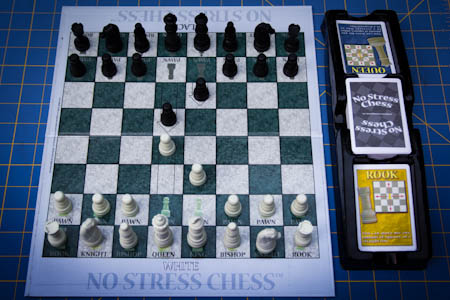How To Teach A Young Kid To Play Chess
Posted by
on under
My eight year old son has been asking me to teach him how to play chess for several months. I honestly avoided it because I worried that he was too young to learn, I did not want him to become frustrated with the game before he was able to memorize all the rules for how the pieces move and actually play.
Well, he couldn't take it anymore and yesterday (his first day of summer vacation) he cornered me and made me promise I was going to teach him.
I don't know about you, but when I have a really difficult problem to solve (not stuff like math or computers, I mean very difficult problems like this one) I just go to my wife for help. So she went online, searched, and came up with a winner.
This board game she found is called No Stress Chess. It is a variation of the regular chess game that is specifically designed so that people with absolutely no knowledge of the game can sit down and start playing right away, without having to learn any rules.
The game is played on a regular chess board, but the board that they provide is double sided. On one side the board indicates where the pieces go at the beginning of the game, while the other side is a plain board for players who already know the positions.

To play No Stress Chess all the pieces are positioned like in regular chess, except for the King and Queen Pawns, which are advanced one and two squares respectively, as indicated in the board hints.
Instead of moving pieces freely, players take turns in drawing cards from a 56 card deck. The card tells the player what piece to move. Printed on the card are the picture of the piece, the name, and a board diagram that shows how it moves.

The goal of the game is not to check mate the opponent's King but to capture it. This is a necessary change, since players do not have the freedom to move any piece that they wish so it may not be possible to escape a check.
Special moves like promotion, en passant capture and castling are not part of the game, the goal is to learn the basic moves first.
My son picked it up immediately. We played a couple of games yesterday and I helped him decide how to move, introducing basic strategy concepts. Since the game has a random component the chances of winning are more even, in fact the first game we played he won. After we played those two games he kept practicing for a while, drawing cards and moving the pieces for both sides.
Today he went to set up the board to play another game with me. Imagine my surprise when I see that he inadvertently put the clean board up, the one that does not have the position hints, and started setting up the pieces for both sides without even noticing that he had already memorized them. He even got the King and the Queen in the right places!
We played three or four games today, and by the last game he had already memorized how all the pieces move except the Pawn, which still confuses him a bit. It's not going to take long until we can drop the cards and start playing real chess.
Based on the progress my son has made in just two days, I'm completely sold on No Stress Chess. Best $15 I have spent in a very long time!
Miguel
-
#1 Andrei Duma said
It's nice that you want him to really like the game. It would have been easier (and cheaper, may I say) to simply squeeze the rules into his head, but in the long run, we would have got bored.
-
#2 Miguel Grinberg said
@Andrei: sure, but knowing my boy's short attention span I know that would not have worked, he would have dropped out long before he could have played his first game. With this method we started playing right away.
-
#3 Al said
I remember when I learned to play, as a kid, I had a game where each piece was a cardboard cut out, showing where the piece could move. Once I understood that we switched to the real, "grown up" pieces. ... I still think it's a good way to learn the basics (even if my play isn't much better now than when I was eight :-)
-
#4 Kobe Bryant is The Best said
Chess is great, and you will love it if you will learn more about it. To improve at chess you need to study endgames, tactics and strategy. You can learn these from books. Once your son is already familiar with the rules of chess, let him solve easy chess tactic problems like pin,fork, 2 moves mate, 3 moves mate etc. Teach him basic endgame mates of two rook vs king, queen and king vs king, rook and king vs king. I suggest you buy chess tactics for champion book by polgar, so that you many tactics problem that your son can solve.
-
#5 Helen said
There are 56 cards but could you tell me how many there are for each piece? I want to make a set of cards to teach me 7 year old using our own board
-
#6 Ruby @justdk said
Nice blog. I like this amazing article and will share with my family groups. Thanks for posting!


